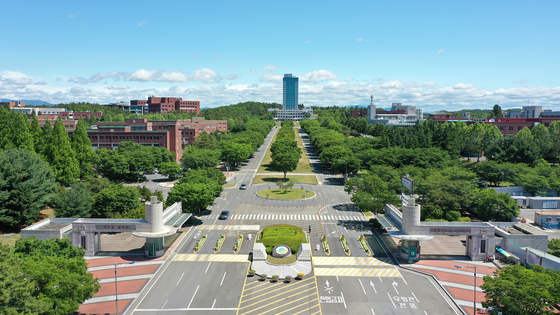![Daegu University view. [사진 대구대]](https://i0.wp.com/pds.joins.com/news/component/htmlphoto_mmdata/202103/07/843a5374-778f-4f19-9594-b95bdb2b3952.jpg?w=560&ssl=1)
Daegu University view. [사진 대구대]
Daegu University President Kim Sang-ho announced his intention to resign after taking responsibility for not filling the enrollment quota this year.
According to an official at Daegu University on the 7th, President Kim commented on the bulletin board inside the university recently, saying, “I only promise that a new executive department will be launched before the end of this semester” under a post asking the president to be responsible for the failure to take the entrance exam. It is reported that he posted a nuance on the bulletin board on the 2nd day, the first day of the class, saying, “It is better to show responsibility without being stuck in a seat”.
![Sang-ho Kim, President of Daegu University. [사진 대구대]](https://i0.wp.com/pds.joins.com/news/component/htmlphoto_mmdata/202103/07/78753798-938f-4b34-ad09-f0637eee6afe.jpg?w=560&ssl=1)
Sang-ho Kim, President of Daegu University. [사진 대구대]
There was no official announcement by the university, but in fact, it indicated that he would withdraw from the position of president. In this year’s college admissions, as local colleges who couldn’t fill their gardens, there are many sayings that'(university) will fall in the order of cherry blossoms’, but Daegu University is the first case that has spread to the resignation of the president.
Daegu University’s enrollment rate for freshmen in the 2021 school year was 80.8%, down 19 percentage points from the 2020 school year. This is the final registration rate obtained by proceeding with additional recruitment last month due to the large under-capacity range.
Additional recruitment will be conducted only if the full number of applicants is not filled even though additional candidates are selected from the regular recruitment. President Kim, a professor in the Department of Library and Information Science, took office as president through an intra-school election in May 2018. The term of office is until next May.

Yeungnam University College Job Center, where all final exams for the 2nd semester ended last December. A job preparation student is looking at employment information. News 1
Not only Daegu University, but also the nearby Daegu area four-year colleges have a serious shortage of capacity. All additional recruitment has been carried out, but none of them have led to a 100% final registration rate.
Daegu University recorded a final registration rate of 80.8%, while Daegu Catholic University recorded a registration rate of 83.8% (100% the previous year). Daegu Haany University accounted for 96.2% (99.93% the previous year) and Kyungil University 97.6% (99.3% the previous year). The national university Kyungpook National University and Keimyung University, which are famous for their pretty campuses, also showed only 98.51% (99.81% in the previous year) and 98.46% (99.98% in the previous year) enrollment rates, respectively.
With an average employment rate of 80.3% for the last five years, Youngjin College, which had even re-entry students after graduating from a four-year college, also had a registration rate of 90.4% for freshmen this year. Youngjin College continued to record 100% registration until last year. Yeungnam University is the only university in Daegu with a record rate of over 99% (99.7% last year, 99.4% this year).
This shortage of recruitment for new students is a national phenomenon, but it is more severe in the provinces. According to the Korea Council for University Education, the number of additional recruits held at 162 four-year universities this year was 26,129, nearly three times higher than that of the previous year (9830). The problem is that most of the additional recruitment is concentrated in local universities in the non-metropolitan area.
The number of additional recruits in Seoul, Gyeonggi, and Incheon was 2240, accounting for only 8.6% of the total. However, the number of non-metropolitan areas was 23,889, or 91.4%. By region, Gyeongsangbuk-do had the highest number with 4331 people.
University admission experts and universities gathered saying, “The decline in the school-age population in Korea, the preference for universities in the metropolitan area, and difficulties in the family economy due to the spread of the novel coronavirus infection (Corona 19) are the main causes, and the problem will intensify in the long run.” .
Daegu = Reporter Yunho Kim
[email protected]
![]()
